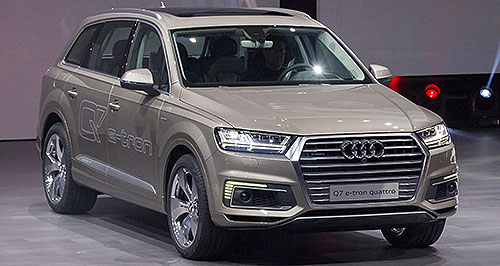Future models - Audi - Q7 - e-tron 2.0 TFSIShanghai Show: Audi debuts petrol-powered Q7 e-tronFuel’s choice: Audi’s Q7 range now offers both diesel-electric and petrol-electric powertrains, but only the diesel is slated for Australia at this stage. Audi adds another e-tron variant, but petrol-powered Q7 hybrid is unlikely for Oz20 Apr 2015 By TIM ROBSON AUDI has shown off a second plug-in hybrid version of its new Q7 at Auto Shanghai – alongside and electrified version of the long-wheelbase A6 sedan – this time incorporating the company’s widely used 2.0-litre turbocharged four-cylinder petrol engine. GoAuto reported last month that the first diesel-electric Audi is set to arrive in Australia later in 2016, but the future of the petrol-engined version looks tied to Asian markets, including China, Japan and Singapore. Audi Australia communications executive Shaun Cleary said that the local arm was not expecting the petrol variant to be made available for sale in Australia, despite the fact it will be built in right-hand-drive. “We’re looking forward to the arrival of the Q7 e-tron 3.0 TDI, which we should see in Australia around mid-2016,” he told GoAuto. “The 2.0 TFSI version is intended for Asian markets.” The Q7 petrol e-tron uses the same parallel hybrid arrangement as its diesel twin, using a 94kW/350Nm electric motor mounted within its eight-speed dual-clutch transmission in conjunction with the EA888 four-cylinder’s 185kW and 370Nm output for a combined maximum total that is capped at 370kW and 700Nm. The Q7’s 0-100km/h time has been measured at 5.9 seconds, while its maximum top speed is 220km/h. Its fuel consumption is said to be as low as 2.5 litres per 100 kilometres, based on Chinese measurement criteria, along with a CO2 figure of “less than 60” grams per kilometre, according to Audi. A new heat pump system captures excess heat created by the hybrid system, which serves not only to heat the cabin faster than normal, but also adds up to 20 per cent to the electric-only range of the Q7. Regenerative braking and a coasting mode also provide additional efficiencies to the electric system. The company claims the Q7 has a pure electric range of 53km from its 168-strong array of lithium-ion batteries, along with the potential to recharge them from a three-phase power socket in just two and a half hours. The petrol-powered Q7 plug-in hybrid has a theoretical range of 1200km. In comparison to its diesel sibling, the petrol is not quite as accomplished – the electrically assisted oiler can manage 56km of EV range and 1410km overall. Its combined output figures of 275kW and 700Nm are comparable, but the diesel is slower to 100km/h at six seconds flat. It is claimed it will consume just 1.7L/100km. The architecture of the Q7 petrol hybrid differs little from its diesel sibling – or indeed that of the regular Q7. Built on the Volkswagen Group’s MLP platform, an all-new five-link suspension arrangement contributes to a weight saving of up to 325kg over the outgoing car, along with a greater use of aluminium for castings and panels. Externally, the e-tron sports a unique grille, air intakes, rear diffuser and 19-inch wheels to set it apart from its regularly powered stablemates. Q7 e-trons also pick up Audi's 'virtual cockpit', complete with a 12.3-inch digital instrument cluster to display information such as energy flow, battery charge level, power meter and a regular tachometer. Standard spec includes 19-inch rims, automatic air-conditioning, Audi’s 'connect' system that allows the car to hook up to the internet, collision avoidance assist, cross-traffic alert, trailer assist and adaptive cruise control. Meanwhile, the German company has used the Shanghai show to roll out a plug-in hybrid version of its long-wheelbase A6 specifically for the Chinese market, fitted with the same basic petrol-electric e-tron drivetrain as the Q7. Its overall performance figures are slightly lower – 180kW and 500Nm from its 2.0-litre petrol engine and gearbox-mounted electric motor, with a 0-100km/h time of 8.2sec and a top speed of 210km/h. The 2000kg sedan is fitted with a smaller battery array that is fitted under the boot floor, which equates to 50km of range. Its fuel consumption is said to be 2.2L/100km. The A6 will be built in the FAW-VW plant in Changchun, and will join the A3 e-tron and the Q7 2.0 e-tron TFSI in the Chinese market in 2016.  Read more3rd of March 2015  Geneva show: Audi powers up Q7 e-tronAudi's plug-in Q7 e-tron sips 1.7L/100km and races from 0-100km/h in 6.0 secondsAll future models Alfa Romeo Alfa Romeo Abarth Abarth Audi Audi Aston Martin Aston Martin BMW BMW Bentley Bentley Chrysler Chrysler Chevrolet Chevrolet Dodge Dodge Citroen Citroen Ferrari Ferrari DS DS Ford Ford Fiat Fiat FPV FPV Foton Foton Haval Haval Great Wall Great Wall Honda Honda Holden Holden Hyundai Hyundai HSV HSV Isuzu Isuzu Infiniti Infiniti Jeep Jeep Jaguar Jaguar Lamborghini Lamborghini Kia Kia Lexus Lexus Land Rover Land Rover Mazda Mazda Maserati Maserati Mercedes-Benz Mercedes-Benz McLaren McLaren Mini Mini Nissan Nissan Mitsubishi Mitsubishi Peugeot Peugeot Opel Opel Proton Proton Porsche Porsche Renault Renault Ram Ram Saab Saab Rolls-Royce Rolls-Royce Smart Smart Skoda Skoda Subaru Subaru SsangYong SsangYong Tesla Tesla Suzuki Suzuki Toyota Toyota Volvo VolvoQ7 pricing
Motor industry news |
Click to shareAudi modelsResearch Audi All future models Alfa Romeo Alfa Romeo Abarth Abarth Audi Audi Aston Martin Aston Martin BMW BMW Bentley Bentley Chrysler Chrysler Chevrolet Chevrolet Dodge Dodge Citroen Citroen Ferrari Ferrari DS DS Ford Ford Fiat Fiat FPV FPV Foton Foton Haval Haval Great Wall Great Wall Honda Honda Holden Holden Hyundai Hyundai HSV HSV Isuzu Isuzu Infiniti Infiniti Jeep Jeep Jaguar Jaguar Lamborghini Lamborghini Kia Kia Lexus Lexus Land Rover Land Rover Mazda Mazda Maserati Maserati Mercedes-Benz Mercedes-Benz McLaren McLaren Mini Mini Nissan Nissan Mitsubishi Mitsubishi Peugeot Peugeot Opel Opel Proton Proton Porsche Porsche Renault Renault Ram Ram Saab Saab Rolls-Royce Rolls-Royce Smart Smart Skoda Skoda Subaru Subaru SsangYong SsangYong Tesla Tesla Suzuki Suzuki Toyota Toyota Volvo VolvoQ7 pricing
Motor industry news |


























Facebook Twitter Instagram